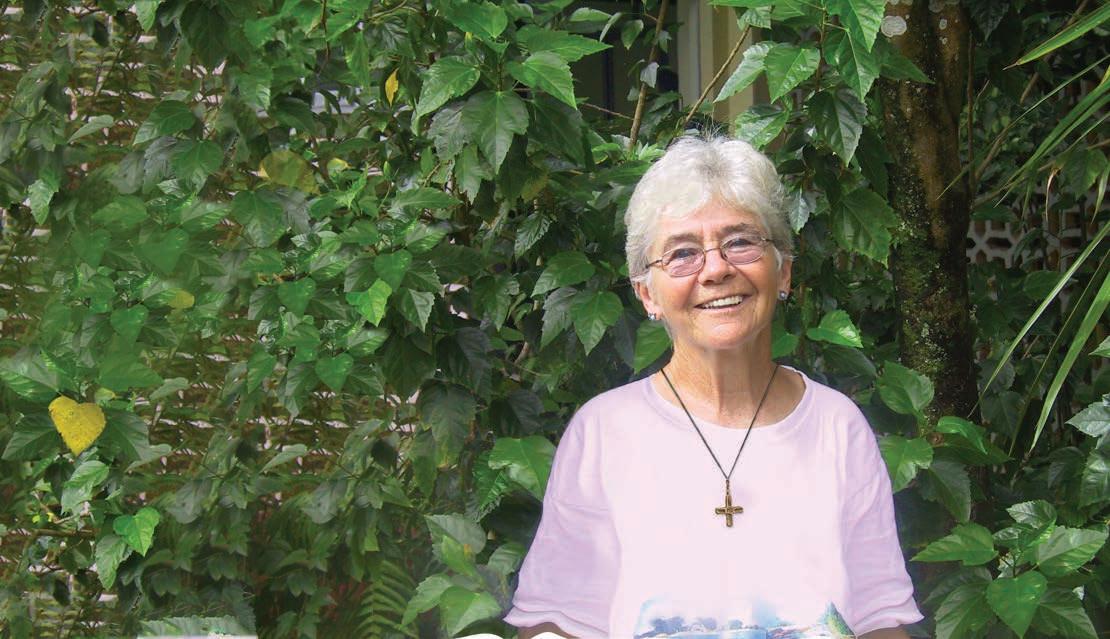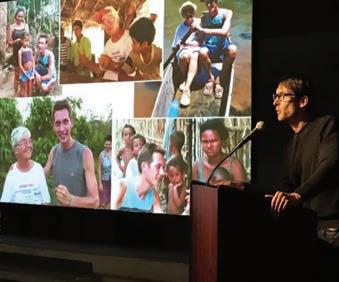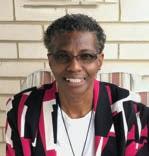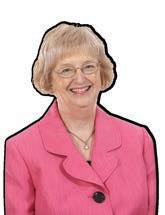CROSS CURRENTS

SISTER
DOROTHY STANG
HER LEGACY ENDURES…PROPHETS FOR A NEW ERA

CROSS CURRENTS
Summer 2020 | Vol. 16 / Issue 2
Sisters of Notre Dame de Namur change lives by making known God’s goodness with you.
Throughout the world, we are committed to education. We take our stand with those living in poverty, especially women and children in the most abandoned places. Cross Currents is published two times a year for friends of the Sisters of Notre Dame de Namur by the Ohio Province Development Office.
We invite reader responses on the content of this publication or on the work of the Sisters of Notre Dame de Namur. Comments may be submitted to Kevin Manley, Director of Development, at kmanley@ ohsnd.org.
Sisters of Notre Dame de Namur Ohio Province
701 E. Columbia Avenue Cincinnati, OH 45215 513-761-7636 / 513-761-6159 (fax) www.sndohio.org
Leadership Team:
Sister Kathleen Harmon, SNDdeN, Provincial
Sister Donna Marie Jurick, SNDdeN
Sister Patricia Loome, SNDdeN
Publisher: Kevin Manley kmanley@ohsnd.org
513-679-8117
Writer: Joe Foley

Editor: Angela Weisgerber
Photography:
Cover and pages 3, 4 & 7: Courtesy of the Sisters of Notre Dame de Namur Congregational Mission Office
Page 5: Still photo from the documentary, The Student, the Nun & the Amazon, courtesy of Samuel Clements
Page 6: Mary Dee Donovan
All others by staff
COVER:
The year 2020 marks the 15th anniversary of the martyrdom of Sister Dorothy Stang in the Amazon jungle.
SISTERS OF NOTRE DAME DE NAMUR
LEAVING A GODLY LEGACY
We all hope to leave a positive legacy. For some of us, we do so through our children and all the sweat and toil it takes to raise them.
For some of us, our legacy is our career and how that career makes the world a better place. The Sisters of Notre Dame de Namur, individually and collectively, seek to leave a legacy as well, and have they ever been successful! You can measure this legacy in the tens of thousands of students whose minds and hearts are filled with Christian sensibility and Christ’s charity toward others.
You can see it in the schools spanning the nation and circling the globe, and that continue to bring children and young adults to enlightenment and sound reason.
And you can see it, too, in the selfless labor of people such as Sister Dorothy Stang, who was martyred fifteen years ago because of her work to protect creation and to protect some of Brazil’s most marginalized people.
“Whoever wishes to come after me,” Christ said, “must... take up the cross and follow me.”
Sister Dorothy, on the lonely dirt road where she was shot, was doing just that. That is her legacy, and it will live on through the ages.
Sincerely,
Director of Development

DOROTHY
In the town of Anapu, Brazil, in the Wild West of the Amazon, a little girl said to the man handing out posters with an image of Sister Dorothy Stang, “I want one, too.”

“No,” the man told her. The priest had said only one poster to a family, and the man had already given a poster to the little girl’s mother.
“But I want one,” the girl said.
“No,” the man said.
“But Dorothy is my friend,” the little girl said. “And she wants me to have one!”
Sister Dorothy Stang was murdered 15 years ago. The little girl is six or seven.
Such is Sister Dorothy’s presence, even today.
3 CROSS CURRENTS
CONTINUED ON PAGE 4
Sister Maria Vagner Souza Silva (center) teaches biblical studies in the Sâo Joâo Batista community in Anapu.
“Yes, Dorothy is alive and present,” says Sister Jane Dwyer, who worked alongside Sister Dorothy, and who along with Sister Kathryne “Katy” Webster remains in Anapu carrying on the work.

“In Belém and Altamira (the state capital and a small city to the west, respectively),” Sister Jane says, “everyone says Sister Dorothy had coffee at their house, or she took my taxi, or even that she had a beer there.”
And the Sisters, she says, now all of them are called ‘Dorothys.’ The same holds true for people who go into the forest to side with the subsistence farmers. They are ‘Dorothys’ as well.
“The poor, they’ve taken her on,” says Sister Jane. “She is their witness, their protector.”
Sister Dorothy, a Dayton, Ohio native, began her work in Brazil in 1966 after 15 years as an elementary school teacher in Illinois and Arizona. In 1982, she moved to Anapu to participate in the government-sponsored sustainable development projects, which were an effort to resettle landless, often indigent, families from overcrowded urban areas to small, family farms in the Amazon. Many of these same families Dorothy already knew.
The homesteading efforts, however, and in short order, interfered with the illegitimate and often illegal claims to the land by loggers and ranchers, which set the stage for years of violent conflict, conflict responsible for Sister Dorothy’s assassination
along a lonely stretch of road, and that continues today.
But Sister Dorothy’s legacy, in very concrete ways, lives on.
The small community schools she established, away from town and in the forest near the families of the farmers, continue, and with a strong agricultural curriculum.
The consciousness and activism on the part of the farmers regarding protection and replenishment of the natural environment remains rigorous, such that farmers are maintaining and replanting trees
over up to 80 percent of their properties, and substituting forest-friendly crops such as cacao, black pepper and açaí in place of corn.
And perhaps most importantly, Sister Dorothy’s organization of the farmers into a cohesive and powerful force, where once they were isolated and distrustful of one another, has only grown stronger, allowing them to hold onto their land through initiatives of their own and through organizations of their own creation, such as the Anapu Defense Committee.
4
ABOVE
Sisters Jane Dwyer (left) and Kathryne “Katy” Webster continue the mission and legacy of Sister Dorothy.
“There is an atmosphere now of ‘we can do this,’ says Sister Katy, who arrived in Anapu in 1993. “It’s intangible but it’s an attitude of ‘we can do it.’”
Global Legacy
Shortly before Sister Dorothy’s death, 23-year-old English university student Samuel Clements was in the south of Brazil working on his environmental sciences dissertation, but wanted to go north into the Amazon. Greenpeace — often in Brazil surrounded by barbed wire and with its employees wearing bulletproof vests — put him in touch with Sister Dorothy. He called her on the phone, and only later opened


a map to see how he could reach her. Two plane rides, a boat, a bus and motorbike ride later, he met her in Altamira. Accompanying him was a videographer he had invited from England to document Sister Dorothy’s work. Immediately upon arrival, the tenseness of the situation was palpable.
“We had to keep in the shadows that first night,” Samuel says. “We had to keep the cameras down. I remember Sister Dorothy kind of hiding when certain men went by.”
Samuel and the videographer traveled with Dorothy to Anapu and also into the forest. They met and broke bread with families in the sustainable development communities. They filmed, spoke with Sister Dorothy at length, and learned as much as they could. They saw firsthand, as Samuel says, “the persecution of the people, and the slaughter of the trees.”
Then, after three or four days, they left.
“It was very short,” Samuel says. “She was worried about our safety.”
5 CROSS CURRENTS CONTINUED ON PAGE 6
There is an atmosphere now of ‘we can do this.’ It's i ntangible but it’s an attitude of ‘we can do it.’”
— SISTER KATY
ABOVE Sister Dorothy inspired Samuel Clements to share her vision of the interconnectedness of life with others.
Several months later, before Samuel had even wrapped up the editing of The Student, the Nun and the Amazon, which would later become a defining documentary seen all over the world, Sister Dorothy was dead.
On the Ground — Now
“When they killed Dorothy, it had such repercussions,” says Sister Katy. “They [the large landholders] didn’t expect it. So they fell back, regrouped. They said, ‘How are we going to do this now?’”
The election of Brazil’s current farright president — Jair Bolsonaro — has in part provided an answer. President Bolsonaro has dismissed officials responsible for protection of the Amazon, and for the land rights of people who live there. He’s gutted the National Institute of Colonization and Agarian Reform, an organization established to bring order to land reform, and has undermined — officially and unofficially — laws aimed at deforestation and reigning in illegal ranching, mining and logging, including in the Anapu area.
At the same time, murders and assassinations that had abruptly declined after the global publicity and condemnation surrounding Sister Dorothy’s death, are rebounding. A red cross, installed beside Sister Dorothy’s tomb, now bears the names of 19 farmers murdered.
“They [the landowners] have changed their tactics,” says Sister Katy. “They kill farmers away from their property. They kill them in town, or at festivals, or on the streets. They do it so it will be camouflaged, so it will be covered. But we know they did it. The people know they did it.”
“Dorothy was a mother figure,” says Sister Jane. “She was a leader in that moment because she had to be. The two of us [Sisters Jane and Katy], we’re friends, companions and sisters. Our principal purpose here now is to be a voice to the outside world.”
Knowing Dorothy
“Oh, I wish I could have known her, could have worked with her,” a priest in Anapu once said, and to which a woman responded, “Well, she left a lot of seeds here.”
ABOVE
In early February 2020, Samuel Clements spoke at the Mount Notre Dame convent in Cincinnati, OH and shared his reflections about Sister Dorothy and the environment.

And a lot of seeds all over the world, including in Vatican proclamations, U.S. Congressional resolutions and a United Nations Human Rights award. But also quietly in the hearts and minds of individuals.
" She’s there as the smile that greeted me,” says Samuel Clements, from England. “I recall that vividly. The softness of her voice, the strength of her beliefs. She saw the goodness of people, and could draw that out. It’s made me a fuller human being. I understand I can be kinder, wiser and more courageous.”
And from Dayton, Ohio, Sister Dorothy’s 16-year-old grandniece Madalyn (Maddy) Richardson, just an infant at the time of her greataunt’s death, has taken up the environmental mantle.
6 SISTERS OF
NOTRE DAME DE NAMUR
Beginning at age 5 or 6, she began learning from family members of her great-aunt’s cause, of her spirituality and of her eventual martyrdom. Now, Maddy recycles, uses as little electricity as she can, and for her senior capstone project at Chaminade-Julienne High School, will focus upon the environment. “There’s only one planet and we have to protect it,” she says. “We have to take care of it just as God would take care of it.”
Then she says, after a pause, “She [Sister Dorothy] changed the
world in such a short amount of time, but she did so much in that time that will last forever.”
As in Brazil, where the name Dorothy is not just a proper noun anymore, but is a name for anyone who goes into the forest to protect creation and to be one with the families who live there.
“We lived with Dorothy as a companion,” says Sister Katy. “But she isn’t the same woman now who we lived with. She is bigger than us, and we give her to the world.”
Sometimes, where Sister Dorothy is buried at the Sâo Rafael Training

ABOVE People honor, imitate and pray to Sister Dorothy during the Forest Pilgrimage to her gravesite each July.
Center, which she helped found and which is surrounded by forest and gardens and only accessible on foot, pilgrims will come. Some travel from long distances, and some on a regular basis. Often, on the road that runs not too far away, truckers will park their trucks. They will walk through the trees, cross the cable bridge, and pray before Dorothy’s tomb.
“Dorothy marked Brazil,” says Sister Jane. “She marked the world.”
7
NEWSBRIEFS
protective equipment, and airing public service announcements on radio. It’s also stressing frequent hand-washing among the populace, and along with the diocese has set out hand-washing stations at many of the food markets. The stations consist of a spigot attached to a twogallon bucket.
“But who will refill the buckets?” says Sister Emily. “And the soap will be gone in an eye blink.”
And while the Sisters are wearing masks in public, limiting the number of visitors inside their compound and likewise making limited trips out, many in the community aren’t so vigilant.
ON THE BRINK IN THE DEMOCRATIC REPUBLIC OF CONGO
The afternoon of May 13, five cases of suspected coronavirus were reported in Kisantu, Democratic Republic of Congo, where the Sisters of Notre Dame de Namur have a convent and school. This comes seven months and two weeks after that same convent burned to the ground. Sister Emily Mullen was there for both, and is there still. She is a nurse, head of the Diocesan Office of Health Ministry, and helps oversee the local hospital. In the fire, in the middle of the night, she was on the second floor when flames broke out. She and the other Sisters organized a bucket brigade going up and down the steps, but the fire was too big. There is a sense now that as with the fire, Covid-19 might be too big.
“A lot of people aren’t ready to really
believe this is happening,” she says. “But it is happening.”
Over a thousand cases have been reported in the national capital of Kinshasa, 65 miles to the northeast, and an additional 50 in the province capital of Matadi.
In Kisantu, where Sister Emily is a member of the district task force charged with preparing for the virus, schools have been closed since March 20, including the Notre Dame schools attended by 1,500 students, 600 of whom prior to the closing lived on the convent grounds. The diocesan hospital has also been named as one of three Covid-19 reception points in Kongo Central Province, in which Kisantu lies. “So far, we’ve set aside eight beds,” Sister Emily says, “but I’m not sure eight is going to be enough.”
The task force is distributing facemasks, gathering personal
“It’s challenging,” says Sister Emily. “Many people have to go to the market every day, so you see people on motorcycles, two or three on a motorcycle, and they’re supposed to be wearing masks, but they’re not.”
Funding to fight the virus is in part coming from Germany and the European Union, which are allowing previously designated funding to be redirected in light of the current crisis.
As for reconstruction of the convent, demolition of what was left after the fire has been completed, with excavations having begun in late April to dig out remnants of the old foundation, laid in 1900, to make way for its replacement. That work, however, is on hold due to the pandemic. In the meantime, the Sisters forced out by the fire continue to live in an adjacent guesthouse, preparing and contending as best they can while they wait to see which way the crisis goes.
“It could change drastically in a week,” says Sister Emily. “That’s my experience.”

8 SISTERS OF NOTRE DAME DE NAMUR
Sister Emily Mullen in the maternity ward of the local hospital.
NOTRE DAME BAKERY AN ESSENTIAL BUSINESS
The Notre Dame Bakery (Boulangerie Notre Dame) in Les Cayes, Haiti — long-supported by the benefactors of the Ohio Province — has been declared an essential business by the Haitian government during the ongoing COVID crisis. As such, the bakery is continuing to provide essential foodstuffs for the 126,000 people in Les Cayes and those in surrounding communities.

Both employees of the bakery and its contracted sellers have been trained by NGOs in best practices to avoid contact and the spread of the virus. Employees working within the bakery, and sellers working on neighboring streets, are wearing face masks and gloves and practicing social distancing as much as possible. The bakery is producing between 1,600 and 1,800 bags of bread each day, the most ever, and selling in neighborhoods farther from its location.
Ohio Province donors purchased the oven for the bakery in 2015, helped with repairs after Hurricane Matthew in 2016, and have contributed ongoing operating support. The bakery employs 18 inside workers and contracts with 35 sellers, providing job skills and a path out of poverty.
SR. PATRICIA CHAPPELL RECEIVES LCWR OUTSTANDING LEADERSHIP AWARD
Sister Patricia (Patty) Chappell, East-West Province Moderator, will receive the Outstanding Leadership Award of the Leadership Conference of Women Religious (LCWR) at its national conference in August.
The award honors Sister Patty for her contribution “as a woman religious to the work of Gospel justice, compassion, truth and peace.” Sisters from religious congregations across the 15 LCWR regions nominated Sister Patty for her witness and commitment to anti-racism and the dismantling of white privilege.
Sister Patty served nine years as executive director of Pax Christi USA, and as a founding member and President (19962001) of the Black Sisters’ Conference.

SR. JUDITH MERKLE PUBLISHES BOOK
Sister Judith Merkle, SNDdeN, recently published About Discipleship, Secularity, and the Modern Self. The book examines the situation of Christian spirituality today, in a secular age, through the images of dance, silence and music. Drawing on the work of Charles Taylor as well as core aspects of the tradition of Christian theology on discipleship, Merkle asks how these new conditions affect the practice of Christianity as modern discipleship. She explores this discipleship as a lens through which we can understand how a community of faith, service, prayer, worship and sacramentality can be viewed and integrated in daily life.

9 CROSS CURRENTS
SISTERS OF NOTRE DAME DE NAMUR
WE WILL ALWAYS REMEMBER
SISTER RUTH ELLEN EVERS SND deN
Formerly Ann Timothy • July 23, 1926 — March 4, 2020
Sister Ruth Ellen was known as a woman of prayer, a good listener, a risk taker and expert storyteller. Her 37-year educational ministry as teacher and principal was guided by a simple philosophy: love each student, listen to them and open their hearts as well as their minds. After Vatican II, Sister Ruth Ellen saw the need for Sisters to have quality hair care since they no longer wore habits. She studied cosmetology and opened a hair salon at Mt. Notre Dame Dame convent, providing a cheerful smile and listening ear. Sister Ruth Ellen helped people in need, visiting patients and shut-ins and chauffeuring parishioners to appointments.
SISTER CATHERINE JOYCE SND deN
Formerly Sarah Gloria • December 21, 1926 — March 7, 2020
Sister Catherine wrote that her “vocation was nurtured in ordinary and mysterious ways.” Her first 25 years of ministry were in formal elementary education, shaped by collaboration. It wasn’t surprising that in the wake of Vatican II, Sister Catherine offered to serve as principal of an inter-parochial school where she reveled in the challenge of building bridges among children of many ethnic, racial and socio-economic backgrounds. By chance, Sister Catherine learned about and accepted a position as hospital chaplain. She said that in her 21 years providing pastoral care, she “often experienced God more in the hospital than I have in Church.”
SISTER ANNE CECILIA COXEN SND deN

March 8, 1926 - April 11, 2020
Sister Anne Cecilia’s practical living out of the Notre Dame charism was energized by her attraction to teaching people “what they need to know for life.” She spent 27 years in the classroom teaching basic life skills but also recognizing the importance of creativity. She was director of financial aid at Trinity College, where she actively recruited women of all ages, including many unable to afford the tuition. She found herself helping needy students develop practical financial management skills and providing oversight of their loan programs. For these students, her services unlocked doors of opportunity that would have otherwise been closed.
We are mindful that we stand on the shoulders of those who have come before us.
SISTER ADRIENNE WESEMAN SND deN



Formerly Adrienne Marie • March 24, 1930 — April 24, 2020
Sister Adrienne began her religious life in formal education. With the advent of Vatican II, she took on the important challenge of developing new ways of teaching young people about their religion and became a pioneer in the role of director of religious education. For 29 years, Sister Adrienne served as DRE at St. Alexander’s in Villa Park, IL, where she oversaw pre-school through grade 12 religious education programs for the school and parish. For the past 22 years, she served as co-DRE at Our Lady of Wayside Parish in Arlington Heights, IL. She had faith that her students “deepen[ed] my faith…and that knowledge brings me closer to God.”
SISTER JOYCE HOBEN SND deN
Formerly Mary Raphael • May 21, 1929 — May 28, 2020
For 24 years, Sister Joyce served as teacher, principal and diocesan supervisor. Sister Joyce was then called to leadership in the Ohio province where she helped Sisters articulate their gifts and see how God was calling them to use those gifts. During her second term as provincial leader, she worked collaboratively with other religious communities to form the Intercommunity Justice and Peace Center. In 1990, Sister Joyce earned a Licentiate of Canon Law and was appointed Judge/Defender of the Bond for the Chicago Matrimonial Tribunal. She moved to Dayton to care for her siblings in 2000 and continued her canon law work as an adjunct professional. Sister Joyce wrote of religious life, “’where your treasure is, there is your heart also.’” (Mt.6:21)
SISTER MAUREEN SAUER SND



September 15, 1934 — June 19, 2020
deN
Sister Maureen’s heart was in music and singing. “Music is a way for me to pray. Can there be a greater gift?” After a brief time teaching middle school, Sister Maureen began her lifetime vocation in music education and parish music ministry. Sister Maureen taught music at two Notre Dame high schools, taught voice to college students, gave private vocal lessons and served as a vocal specialist for the Chicago Archdiocese. She was the music minister at St. Catherine of Sienna-St. Lucy Parish in Oak Park, IL, where she lived as witness to diversity during an era when integration was a huge issue. After serving in province leadership, Sister Maureen provided music ministry at St. Luke Parish in River Forest, IL.
10
TO
READ A MORE DETAILED OBITUARY OR TO LEAVE A COMMENT, VISIT 'ABOUT US' ONLINE AT: SNDOHIO.ORG
OUR GOOD GOD IS WITH US
These may be times of great uncertainty, but they are also times of renewed hope. The global pandemic has distanced us physically and socially but has exhilarated our faith and optimism in the light that we are all one as family, and that we are all in this together. We count our blessings, and we count on our friends, especially in times like these.
This is why we were so grateful when the Sisters of Notre Dame de Namur were recently notified that Mabel Howatt, a lifelong friend of the Sisters who graduated from Sixth Street Academy in 1933, had included the Sisters in her estate plan. Mabel always held the Sisters close and was very grateful for her education. She would be so delighted to know that her gift is arriving at this critical time when so many of our expenses have increased due to the challenges we currently face.

All Mabel ever wanted to do was to help. Throughout her 106 years, she always stayed in touch with the Sisters. She was blessed to have such a long and bountiful life, and we are so thankful to have the opportunity to continue her legacy. We are always moved by the grace of our friends, and it was Mabel’s wish to do everything she could to help the Sisters.
The Sisters remain committed to our worldwide mission to spread the goodness of God and to minister where others may choose not to go. If you have or are considering including the Sisters in your estate plans, please know how grateful we are for you. Though we cannot congregate in our chapel, know that our prayers for you and your family continue.
As we move forward through these uncertain times and the challenges we will face in the future, we know that our good God is with us. Though we may be physically distanced from each other, we will continue to move forward as one family with faith, fortitude, and most of all, hope. We ask that you please remember the Sisters in your prayers.
For more information, confidentially and with no obligation about ways you can continue to support the Sisters in your will and estate plans, contact Karen Hadden, Associate Development Director, at khadden@ohsnd.org or 513-679-8106.
 KAREN HADDEN Associate Director of Development
KAREN HADDEN Associate Director of Development

CROSS CURRENTS
The Sixth Street Academy and early 20th century Cincinnati graduates
Address Service Requested
SISTER DOROTHY’S LEGACY
For nearly 40 years, Sister Dorothy Stang worked with the poorest people of Brazil. Deep in the Amazon rain forest, she educated the women about health and nutrition. She helped them start small businesses to support their families, and showed the men which crops would grow best in the forest where they lived. She opened one-room schools to teach the children to read and write, and she insisted that every woman, man and child should expect to receive basic human rights. It was her dream that the people could live self-sufficient lives, and use the land in sustainable ways

Come inside and read about the people who are carrying on Sister Dorothy’s legacy 15 years after she was martyred — working directly with the people, inspiring others to respect the dignity of all people, and teaching the youngest generation about preserving our earth

FOLLOW US ON SOCIAL MEDIA + THE WEB

facebook.com/SistersOfNotreDamedeNamurOhio
youtube.com/c/SistersofNotreDamedeNamur
twitter.com/SNDdeNOhio

instagram.com/sndohio
linkedin.com/company/sisters-of-notre-dame-de-namur

COME JOIN OUR P OWERHOUSE: SN D OHIO.ORG O UR 2020 PARTNERS IN AC TION EVENT IS STREAMING ONLINE STAY HOME ENJOY DONATE WATCH OUR STREAMING VIDEO � NOW ON DEMAND � WWW.SNDOHIO.ORG






















 KAREN HADDEN Associate Director of Development
KAREN HADDEN Associate Director of Development



